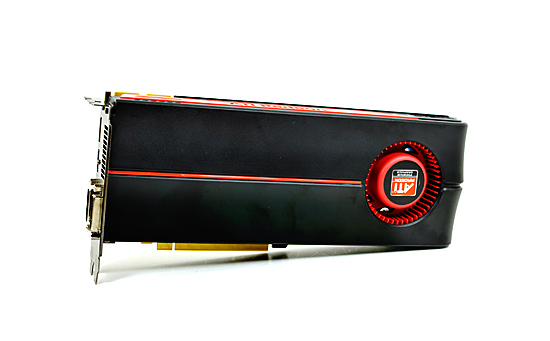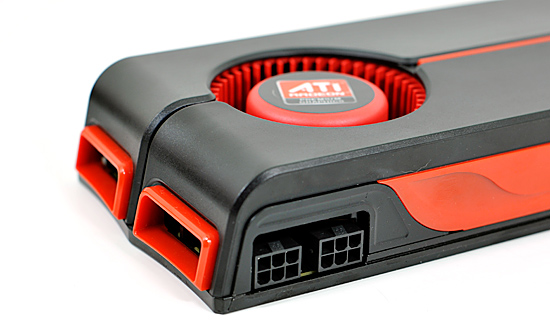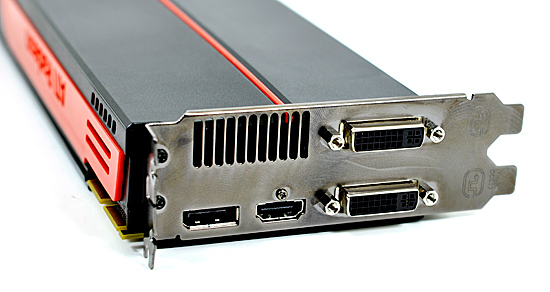AMD's Radeon HD 5870: Bringing About the Next Generation Of GPUs
by Ryan Smith on September 23, 2009 9:00 AM EST- Posted in
- GPUs
Meet the 5870
The card we’re looking at today is the Radeon HD 5870, based on the Cypress core.

Compared to the Radeon HD 4870, the 5870 has seen some changes to the board design. AMD has now moved to using a full sheath on their cards (including a backplate), very much like the ones that NVIDIA has been using since the 9800GTX. The card measures 10.5” long, an inch longer than the 4890 or the same as the 4870x2 and the NVIDIA GTX lineup.
The change in length means that AMD has moved the PCIe power connectors to the top of the card facing upwards, as there’s no longer enough room in the rear. Facing upwards is also a change from the 4870x2, which had them facing the front of the card. This, in our opinion, makes it easier to plug and unplug the PCIe power connectors, since it’s now possible to see what you’re doing.
Since the card has a TDP of 188W, AMD can still get away with using two 6-pin connectors. This is going to be good news for those of you with older power supplies that don’t feature 8-pin connectors, as previously the fastest cards without 8-pin connectors were the 4890 and GTX 285.

Briefly, the 5850 that we are not testing today will be slightly smaller than the 5870, coming in at 9.5”. It keeps the same cooler design, however the PCIe power connectors are back on the rear of the card.
With the 5800 series, DisplayPort is getting a much-needed kick in the pants. DisplayPort (full size) is standard on all 5800 series cards – prior to this it has been rather absent on reference cards. Along with a DisplayPort, the 5870 reference card contains a dedicated HDMI port, and a pair of DVI ports.
Making 4 ports fit on a card isn’t a trivial task, and AMD has taken an interesting direction in making it happen. Rather than putting every port on the same slot of the bracket as the card itself, one of the DVI ports is raised on to the other bracket. ATI could have just as easily only equipped these cards with 1 DVI port, and used an HDMI-to-DVI adapter for the second port. The advantage of going this direction is that the 5800 series can still drive two VGA monitors when using DVI-to-VGA adapters, and at the same time having an HDMI port built in means that no special adapters are necessary to get an HDMI port with audio capabilities. The only catch to this specific port layout is that the card still only has enough TMDS transmitters for two ports. So you can use 2x DVI or 1x DVI + HDMI, but not 2x DVI + HDMI. For 3 DVI-derived ports, you will need an active DisplayPort-to-DVI adapter.
With the configuration AMD is using, fitting that second DVI port also means that the exhaust vent of the 5800 series cards is not the full length of the card as is usually common, rather it’s a hair over half the length. The smaller size had us concerned about the 5870’s cooling capabilities, but as you’ll see with our temperature data, even with the smaller exhaust vent the load temperatures are no different than the 4870 or 4850, at 89C. And this is in spite of the fact that the 5870 is rated 28W more than the 4870.

With all of these changes also comes some changes to the loudness of the 5870 as compared to the 4870. The 27W idle power load means that AMD can reduce the speed of the fan some, and they say that the fan they’re using now is less noticeable (but not necessarily quieter) than what was on the 4870. In our objective testing the 5870 was no quieter than any of the 4800 series cards when it comes to idling at 46.6dB, and indeed it’s louder than any of those cards at 64dB at load. But in our subjective testing it has less of a whine. If you go by the objective data, this is a push at idle and louder at load.
Speaking of whining, we’re glad to report that the samples we received do not have the characteristic VRM whine/singing that has plagued many last-generation video cards. Most of our GTX cards and roughly half of our 4800 series cards generated this noise under certain circumstances, but the 5870 does not.
Finally, let’s talk about memory. Despite of doubling just about everything compared to RV770, Cypress and the 5800 series cards did not double their memory bandwidth. Moving from the 4870 and it’s 900MHz base memory clock, the 5870 only jumps up by 33% to 1.2Ghz, in effect increasing the ratio of GPU compute elements to memory bandwidth.
When looking back at the RV770, AMD believes that they were not bandwidth starved on the cards that used GDDR5. And since they had more bandwidth than they needed, it was not necessary to go for significantly more bandwidth for Cypress. This isn’t something we can easily test, but in our benchmarks the 5870 never doubles the performance of the 4870, in spite of being nearly twice the card. Graphics processing is embarrassingly parallel, but that doesn’t mean it perfectly scales. The different may be a product of that or a product of the lack of scaling in memory bandwidth, we can’t tell. What’s for certain however is that we don’t have any hard-capped memory bandwidth limited situations, the 5870 always outscores the 4870 by a great deal more than 33%.










327 Comments
View All Comments
JonnyDough - Wednesday, September 23, 2009 - link
They could probably use a 1.5 GB card. :(yacoub - Wednesday, September 23, 2009 - link
why is the 5870 so freaking LONG??I'm pretty sure you could land aircraft on it.
http://images.anandtech.com/reviews/video/ATI/5870...">http://images.anandtech.com/reviews/video/ATI/5870...
Someone should photoshop a person into that image for scale. They'd be standing in the shadow underneath the PCIe connector, waving at you, and there would be an F-35 JSF circling like a fly trying to land on the deck.
Ryan Smith - Wednesday, September 23, 2009 - link
It's your standard, full-length 10.5" card. It's the same as the GTX cards and the 4870X2Here's a shot comparing it to a GTX 285 and a 4890 that I didn't get to use in the article.
http://images.anandtech.com/reviews/video/ATI/5870...">http://images.anandtech.com/reviews/video/ATI/5870...
SiliconDoc - Monday, September 28, 2009 - link
If you can't see the 5870 is the longest card in that pic, then you've got different problems than just lying issues.Another one, another big fat fib, with pic included, that proves the fib to be a fab fib.
It's amazing.
---
"No, everyone, do not believe your lying eyes, it's a standard 10.5" measured in the new red rooster barnyard stick."
Cripes call International Weights and Measures, we have warped space time around the new ati card it's so powerful.
LSnK - Wednesday, September 23, 2009 - link
Or plainly spoken, angle independent angle-dependent filtering. How confusing.frozentundra123456 - Wednesday, September 23, 2009 - link
Mildly disappointed in the initial results for this card. It is powerful,admittedly, but it has less than twice the performance of the 4870. Also does not use less power. Maybe I was expecting too much. It surely is not a giant step up like the introduction of the 4xxx series cards. I was hoping for another big leap in performance per watt.I have a feeling that nVidia's 300 series will beat it when it finally comes out, although hopefully ATI will still be ahead in performance per watt and performance per dollar.
I hope they make a good low/midrange card like the 4670 that does not require external power but has increased performance.
Spoelie - Wednesday, September 23, 2009 - link
I reckon you'll see performance improve the coming months, as ATi's compiler improves to use the new instructions more efficiently. The card you see here today will not be the one fighting GT300.Granted, it won't make huge strides, but I guesstimate it to be 5-10% better, depending on circumstance/game, by the november-january timeframe (when GT300 hopefully lands).
Nvidia's baby will probably still be faster, but if the margin turns out to be slim, we'll have another rv770 vs GT200 situation playing out. And when the first wave of DX11 games have hit, somewhere next year, it'll be time to reevaluate again ;).
JonnyDough - Wednesday, September 23, 2009 - link
and I stopped. I had to post this:"Sometimes a surprise is nice. Other times it’s nice for things to go as planned for once.
Compared to the HD 4800 series launch, AMD’s launch of the HD 5800 series today is going to fall in to the latter category. There are no last-minute announcements or pricing games, or NDAs that get rolled back unexpectedly. Today’s launch is about as normal as a new GPU launch can get."
If it's normal for all that crap to happen, wouldn't it be ABNORMAL for AMD to have a great launch? :)
SiliconDoc - Wednesday, September 23, 2009 - link
LOL" . Today’s launch is about as normal as a new GPU launch can get."
I guess he meant "for reviewers" - since the "normal launch" today is "listed on the websites for sale, but greyed out, not available, or pre-order" - meaning NO STOCK.
---
Yehah buddy, that is a "as normal as any launch" so long as it's the immensely favored ATI launching, and not that hated greedy Nvidia...
A normal launch and you can't buy the card...rofl.
JonnyDough - Thursday, September 24, 2009 - link
I wasn't being a fanboi, merely mocking normal launches from several companies. Seems like paper launches almost became the norm for awhile. :P